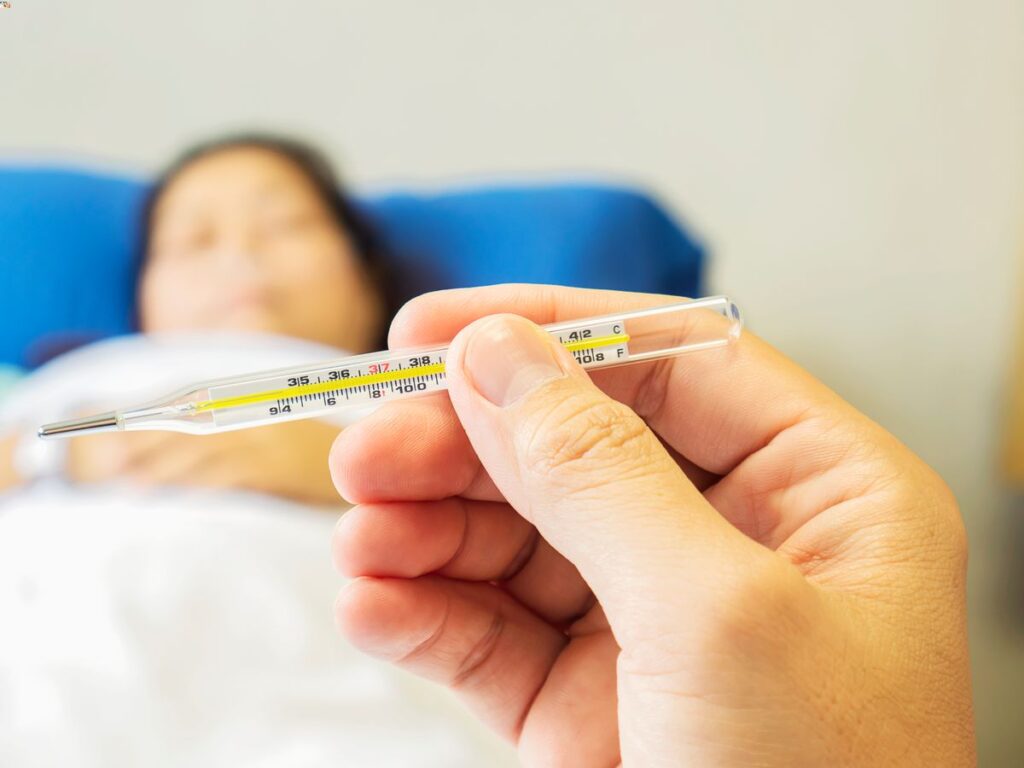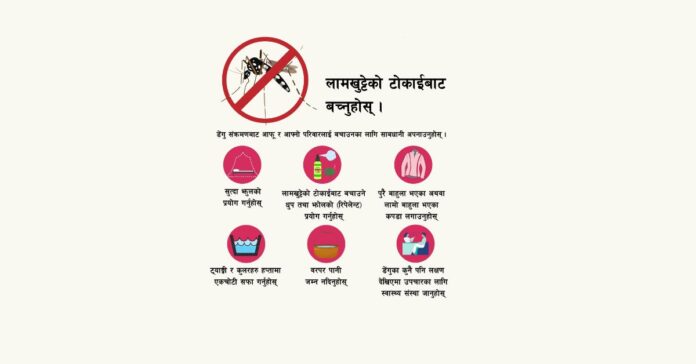Dengue in Nepal has emerged as a major public health concern in recent years. With rising temperatures and increased rainfall, dengue outbreaks have become more frequent across the country.
Therefore, understanding this potentially lethal disease is critical to help prevent and manage infections. This article provides 7 key insights into dengue in the Nepali context – from transmission to symptoms and preventive steps.
1. What Is Dengue?
Dengue is a mosquito-borne viral infection caused by any of the four dengue virus serotypes – DENV 1, DENV 2, DENV 3, and DENV 4. These flavivirus strains are mainly transmitted to humans through the bite of an infected Aedes mosquito.
Furthermore, dengue fever is a severe illness similar to flu, identified by high fever, rashes, muscle and joint pain, nausea, fatigue, and other symptoms.
In rare cases, it can progress to potentially fatal severe dengue characterized by plasma leakage, fluid accumulation, respiratory distress, severe bleeding, and organ impairment.
Timely diagnosis and proper clinical management help to reduce complications and the risk of death.
2. Which Mosquito Causes Dengue In Nepal?
The Aedes aegypti mosquito, also known as the yellow fever mosquito, is the primary vector for dengue virus transmission in Nepal.
It is a small, black and white striped mosquito that prefers to feed on humans during daytime.
Aedes mosquitoes breed in clean stagnant water in artificial containers found near human dwellings like flower vases, old tires, buckets, water tanks, etc.
The female Aedes aegypti mosquito spreads the disease by biting a dengue-infected person and then biting others.
3. How Does Dengue Spread?
Dengue spreads through the bite of an infected female Aedes mosquito. When the mosquito feeds on the blood of an infected person during the febrile phase, it also ingests the virus. The virus then enters the mosquito’s salivary glands.
Once infected, the mosquito can spread the virus to healthy people for the rest of its life through probing and feeding. The virus has an incubation period of 3-14 days.
So transmission can only occur after this period when the infected person starts showing symptoms that an infected mosquito can pick up.
4. What Are the Symptoms of Dengue?
Symptoms of dengue typically begin 3-14 days after an infective mosquito bite. Disease progression occurs in 3 phases:
Febrile phase (2-7 days) – High grade fever, severe body ache, pain behind eyes, nausea, vomiting, fatigue, rash.
Critical phase (24-48 hours) – Fevers reduces but severe symptoms like bleeding, fluid leakage, drop in platelets, and organ damage become apparent, suggesting the development of severe dengue.
Recovery phase – In 2-3 days, there will be a gradual recovery in platelet counts and vital signs along with the reabsorption of fluids that have leaked.

Seeking urgent medical care if warning signs like persistent vomiting, bleeding nose or gums, severe abdominal pain, difficulty breathing, appear during the critical phase.
5. Is Dengue Communicable?
Dengue itself is not communicable and does not spread from direct human-to-human contact or respiratory droplets like flu.
The virus also cannot spread from touching surfaces or dengue patients.
The only way to acquire dengue is through the bite of an infected Aedes mosquito that previously bit another infected person.
The movement of infected humans across regions helps the virus spread geographically, giving rise to outbreaks.
But the disease cannot be transmitted from one person to another in the absence of the mosquito carrier.
6. How Long Does It Take to Recover from Dengue?
Acute symptoms of high fever and body aches during the febrile phase typically improve within 2-7 days. But weakness, fatigue and depression may persist for weeks. Patients with milder dengue will recover fully in about a week.
However, in severe dengue cases with serious bleeding or plasma leakage, the recovery phase is more prolonged.
Hospitalization under close medical monitoring is required for managing organ impairment and fluid management. Complete recovery can take 2-3 weeks or even longer in more vulnerable patients.
7. Preventive Measures for Dengue in Nepal
There is currently no vaccine available to protect against dengue. Prevention relies on controlling the Aedes mosquito population and avoiding its bites:
- Use insecticide treated bed nets and mosquito repellents
- Wear full-sleeved clothing outdoors
- Use window screens and coils
- Eliminate stagnant water from indoor and outdoor spaces
- Use larvicides and fogging to control mosquito breeding
- To lower morbidity and mortality, early diagnosis through blood tests and appropriate clinical management of cases are equally important.
Dengue represents a serious public health threat in Nepal, causing seasonal outbreaks.
However, understanding the disease’s transmission, defining symptoms, course of the illness, and precautions can help communities maintain infection control.
The fundamental principle of managing dengue is clinical preparedness and integrated vector control measures. Integrated vector control measures along with clinical preparedness form the mainstay of managing dengue.
While the vaccine is still under development, avoiding mosquito bites and stopping breeding remain our best protections against dengue for now.
Also Read: Top Electric Scooters of Nepal 2023>>



